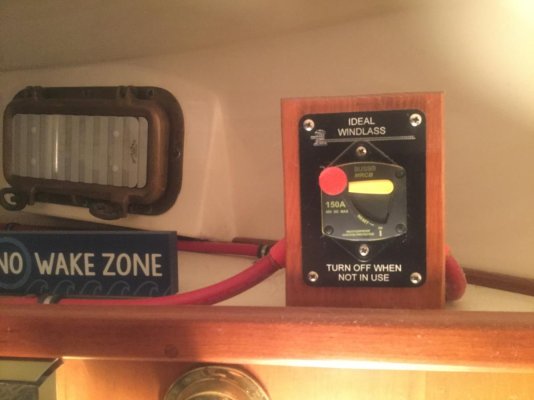Andy G
Hospitality Officer
- Joined
- Sep 20, 2010
- Messages
- 1,897
- Location
- Australia
- Vessel Name
- Sarawana
- Vessel Make
- IG 36 Quad Cabin
Sometimes life just bites you on the bum.
The other day I was doing a walk around on the boat, and decided to have a look at my winch, more specifically I thought as the winch hadn't been used for a month or so, I would remove the chain from the capstan and run the winch to keep the gears oiled.
Like a lot of boats mine has an electric foot switch as well as the wheelhouse remote. I flipped up the plastic cap on the foot switch and lent over to lift the chain off the capstan, unfortunately at the same time I trod on the switch.The result was three fingers holding the chain were drawn down between the chain and the teeth of the capstan. The anchor was now tight up against the pulpit with me well and truly skewered, blood dripping down over my newly painted Lofran.
After some yelling and general use of a few well known anglo saxon descriptive words my partner finally figured out which switch on the flybridge lowered the anchor.
Apart from losing a few finger nails etc, there appears to be no permanent damage, I was lucky.
So what have I learnt, apart from ensuring body parts and big metal things not coming in contact with each other. The main thing I have realised is that your partner must be capable of operating the boat , if for any reason you are not, and in this situation it will probably be highly stressful for all concerned, so your partner must understand this and know what to do under pressure.
Time for this old dog to learn new tricks..
The other day I was doing a walk around on the boat, and decided to have a look at my winch, more specifically I thought as the winch hadn't been used for a month or so, I would remove the chain from the capstan and run the winch to keep the gears oiled.
Like a lot of boats mine has an electric foot switch as well as the wheelhouse remote. I flipped up the plastic cap on the foot switch and lent over to lift the chain off the capstan, unfortunately at the same time I trod on the switch.The result was three fingers holding the chain were drawn down between the chain and the teeth of the capstan. The anchor was now tight up against the pulpit with me well and truly skewered, blood dripping down over my newly painted Lofran.
After some yelling and general use of a few well known anglo saxon descriptive words my partner finally figured out which switch on the flybridge lowered the anchor.
Apart from losing a few finger nails etc, there appears to be no permanent damage, I was lucky.
So what have I learnt, apart from ensuring body parts and big metal things not coming in contact with each other. The main thing I have realised is that your partner must be capable of operating the boat , if for any reason you are not, and in this situation it will probably be highly stressful for all concerned, so your partner must understand this and know what to do under pressure.
Time for this old dog to learn new tricks..

Last edited:





